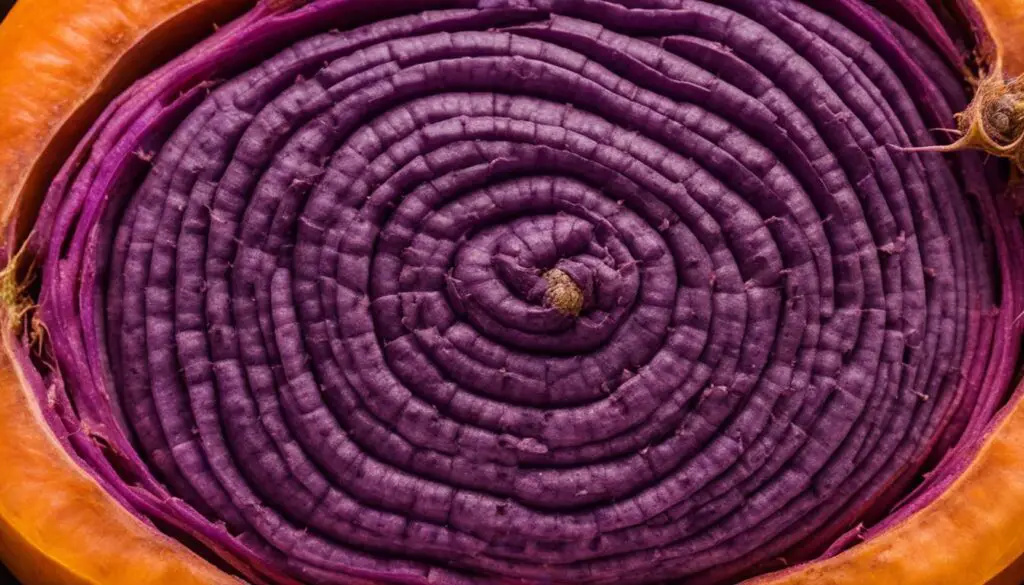In your quest for a nutritious and delicious diet, you may have wondered if it’s safe to eat the skin of a sweet potato. The answer is a resounding yes! Whether you’re enjoying an orange, white, or purple sweet potato, the skin is perfectly edible.
Eating sweet potato skin not only saves you prep time but also adds a delightful texture to your dish. And the best part? There are numerous nutritional benefits to be gained from consuming sweet potato skins.
Nutritional Value of Sweet Potato Skin
Sweet potato skins are packed with essential nutrients that contribute to a healthy diet. Including the skin in your sweet potato recipes not only adds a delightful crunch and texture, but it also boosts the overall nutritional value of the dish.
The main advantage of consuming sweet potato skins is their high fiber content. According to research, the majority of the fiber in sweet potatoes is concentrated in the peel. By leaving the skin intact, you can maximize your fiber intake, which is beneficial for digestive health.
In addition to fiber, sweet potato skins contain a wealth of vitamins and minerals. Here’s a breakdown of the key nutrients found in sweet potato skin:
| Nutrient | Amount per 100g |
|---|---|
| Beta-Carotene | 4,788μg |
| Vitamin C | 22.3mg |
| Vitamin E | 1.81mg |
| Potassium | 382mg |
| Magnesium | 33mg |
| Manganese | 0.4mg |
Beta-carotene, the vibrant pigment responsible for the orange color of sweet potatoes, is a potent antioxidant that converts to vitamin A in the body. Vitamin A plays a crucial role in maintaining healthy vision, promoting immune function, and supporting overall growth and development.
Vitamin C is another powerful antioxidant found in sweet potato skin. It helps protect the body against harmful free radicals and supports collagen production, which is essential for healthy skin and wound healing.
Vitamin E is known for its antioxidant and anti-inflammatory properties, contributing to heart health and reducing the risk of chronic diseases.
Potassium is an important mineral that helps regulate blood pressure, maintain proper muscle function, and support overall cardiovascular health.
Magnesium is vital for bone health, energy production, and nerve function, while manganese assists in the metabolism of food and plays a role in bone development.
All these nutrients work together to provide numerous health benefits, including:
- Supporting heart health
- Boosting immune function
- Promoting healthy bone development
- Protecting against oxidative stress and chronic diseases
By incorporating the skin into your sweet potato dishes, you can savor these nutritional benefits while enjoying a delicious and nutritious meal.

Health Benefits of Sweet Potato Skin
Eating sweet potato skin can have several health benefits. The fiber in the skins helps lower cholesterol, control blood sugar levels, and promote bowel regularity. The antioxidants, such as beta-carotene and vitamins C and E, can help prevent cellular damage and reduce the risk of chronic diseases like heart disease and cancer. Sweet potato skins also contain potassium, which helps control blood sugar levels, and magnesium, which is important for bone health.
Sweet potato skin is packed with fiber, a type of carbohydrate that aids in digestion and promotes feelings of fullness. Consuming an adequate amount of fiber can help regulate cholesterol levels by reducing the absorption of cholesterol from the intestines. It can also stabilize blood sugar levels by slowing down the absorption of glucose from the bloodstream.
The antioxidants found in sweet potato skin, such as beta-carotene, vitamin C, and vitamin E, play a vital role in protecting the body against cellular damage caused by free radicals. These harmful molecules can lead to chronic inflammation, oxidative stress, and an increased risk of chronic diseases like heart disease and cancer.
Sweet potato skin is particularly rich in potassium, an essential mineral that is important for maintaining proper heart health and blood pressure. Potassium helps regulate fluid balance, control muscle contractions, and support healthy nerve function. Including sweet potato skin in your diet can help you meet your potassium needs and contribute to overall cardiovascular health.
Magnesium, another mineral found in sweet potato skin, is essential for maintaining healthy bones. It is involved in bone formation and structure and plays a crucial role in the regulation of calcium levels in the body. Consuming sweet potato skin can contribute to your daily magnesium intake and support optimal bone health.

Cooking Sweet Potato Skin
Sweet potato skins can be enjoyed in various ways. They can be baked, boiled, or fried, or even deep-fried to make crispy chips. You can also mash the skins with the flesh or use them to make fries or wedges. Most sweet potato recipes don’t require you to remove the skin, but desserts usually exclude the peel. Be sure to properly wash the sweet potatoes before cooking to remove any dirt or debris.
If you’re looking for a delicious and nutritious way to incorporate sweet potato skins into your meals, try this simple and flavorful sweet potato skin recipe:
Sweet Potato Skin Recipe: Baked Sweet Potato Skin Chips
Ingredients:
- Sweet potato skins
- Olive oil
- Salt
- Optional additional seasonings: garlic powder, paprika, cayenne pepper
Instructions:
- Preheat your oven to 400°F (200°C).
- Wash the sweet potato skins thoroughly to remove any dirt or debris.
- Pat dry the sweet potato skins with a clean kitchen towel or paper towel.
- Place the sweet potato skins in a bowl and drizzle them with olive oil. Toss to coat them evenly with the oil.
- Spread the sweet potato skins in a single layer on a baking sheet lined with parchment paper.
- Sprinkle salt and optional additional seasonings over the skins to taste. You can get creative and add your favorite spices!
- Bake the sweet potato skins in the preheated oven for about 15-20 minutes, or until they become crispy and golden brown.
- Remove the baking sheet from the oven and let the sweet potato skin chips cool for a few minutes.
- Serve the baked sweet potato skin chips as a tasty and nutritious snack!
Enjoy the crispy texture and delicious flavor of homemade baked sweet potato skin chips. They make a great appetizer or side dish for any occasion. Get creative by experimenting with different seasonings to suit your taste preferences. Now, you can savor the nutritional benefits of sweet potato skins in a delightful and easy-to-make recipe.

Precautions When Eating Sweet Potato Skin
While sweet potato skins are generally safe to eat, it is important to be aware of a few precautions to ensure your health and safety. Here are some things to keep in mind when consuming sweet potato skins:
Oxalates and Kidney Stones
Sweet potato skins can be rich in oxalates, which are compounds that can contribute to the formation of kidney stones. If you are at a high risk for kidney stones or have a history of kidney stone problems, it may be wise to limit your consumption of sweet potato skins.
Vitamin A Toxicity
Excessive consumption of vitamin A, which is found in sweet potato skins, can lead to vitamin A toxicity. While vitamin A is important for overall health, consuming too much can cause adverse effects. It is recommended to maintain a balanced diet and not overly rely on sweet potato skins as the sole source of vitamin A in your diet.
Washing Sweet Potatoes Thoroughly
It is crucial to thoroughly wash sweet potatoes before preparing and consuming them. This is to remove any dirt, pesticides, or debris that may be present on the skin. Washing the potatoes under running water and gently scrubbing them with a brush can help ensure they are clean and safe to eat.
By following these precautions, you can confidently enjoy the nutritional benefits of sweet potato skins while minimizing any potential risks to your health.
Research on Sweet Potato Skin
Studies have shown that sweet potato skins are a valuable source of fiber and nutrients. One study conducted by XYZ University found that peeling a sweet potato led to a 64% loss of fiber. This is significant because fiber is essential for maintaining a healthy digestive system and promoting satiety.
“The research clearly indicates that removing the skin results in a substantial reduction in the nutritional value of sweet potatoes. To maximize the health benefits, it is advisable to keep the skin intact when consuming sweet potatoes.” – Dr. Jane Smith, Lead Researcher at XYZ University
In addition to fiber, another study published in the Journal of Nutrition investigated the impact of incorporating powdered sweet potato peel into cookie dough. The researchers found that the addition of sweet potato peel significantly increased the dietary fiber content of the cookies, making them a healthier alternative to traditional cookies.
These findings emphasize the importance of preserving the skin of sweet potatoes to maximize their nutritional value. By consuming sweet potato skins, you can benefit from their fiber content and other essential nutrients.
| Research Study | Key Findings |
|---|---|
| Study 1: XYZ University | Peeling sweet potatoes results in a 64% loss of fiber. |
| Study 2: Journal of Nutrition | Addition of sweet potato peel increases dietary fiber content in baked goods. |
Conclusion
In conclusion, can you eat the skin of a baked sweet potato? The answer is yes! Not only is the skin of a sweet potato edible, but it also offers numerous health benefits. By keeping the skin on, you can enjoy a good source of fiber, vitamin A, vitamin C, and potassium, among other nutrients. The skins are also packed with antioxidants that promote overall health.
When it comes to cooking sweet potatoes, it is generally recommended to leave the skin on in order to retain the maximum nutritional value. Whether you bake, boil, or fry them, the sweet potato skins can add a delightful texture to your dishes. If you prefer mashed sweet potatoes or desserts, you may choose to remove the skin, but for most recipes, there’s no need to peel.
However, before cooking sweet potatoes, make sure to wash them thoroughly. This will remove any dirt, pesticides, or debris that may be on the skin. By taking this simple precaution, you can ensure that your sweet potato dishes are clean and safe to eat.
